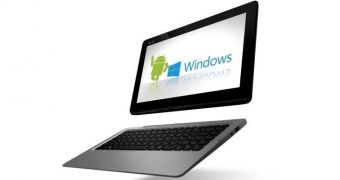Since CES 2014, we found ourselves unable to shake off one question in particular: do dual-boot machines have a future in tech or are just an infatuation of tech giants?
In an earlier article, we argued there’s isn't any real demand on the market for such devices, but vendors like Samsung and ASUS keep pushing the envelope in this respect.
Back in 2013, Samsung announced the dual booting Ativ Q, a device which failed to materialize in retail, due to licensing issues (Google/Microsoft).
But the story was pretty quickly forgotten until ASUS dared pull off a similar stunt, with their Transformer Book Duet, a 2-in-1 machine capable of switching between Android and Windows.
Needless to say, the device never made out to customers either, reportedly due to pressures coming from the two tech giants.
You’d think ASUS would be ready to abandon the sinking ship, but the device manufacturer appears to be persisting in the belief that a dual-OS machine is what customers want.
Anyway, from the flutter of the mainstream, where Google and Microsoft duel just to partner up later on against ASUS, Chinese manufacturers are showing an intense interest in dual-boot machines, reports TweakTown.
According to the new information, Chinese manufacturer are testing out dual-boot tablets with both Windows and Android onboard. At Computex, a bunch of Chinese tablet makers showcased tablets running Windows 8.1 and Android 4.2 and Android 4.4.
The Chinese companies are looking to offer lower-priced, entry-level tablets that are reminiscent of Windows 8 tablets but also offer some Android functionality.
Some dual-OS tablets have already been launched in China. It’s the case of the Ramos i10 Pro, a product that arrives with 3G specifications and the ability to switch between Android 4.4.2 and Windows 8.1.
Unlike the entry-level models purportedly being tested at the moment, the Ramos i10 Pro isn’t half bad spec-wise. The tablet has a full HD resolution (1920 x 1080 pixels) while the chip under the hood is a Bay Trail-T Z3740D combined with 2GB of RAM and 32GB of internal storage.
The 3G function on the tablet comes via an UltraStick 3D SD card, which is offered by Huawei. The Ramos i10 Pro sells for $433 / €314, which isn't exactly super affordable.
However, Chinese manufacturers want to bring these prices further down and they might actually achieve their goal at some point. It’s still interesting to see how they could by-pass the interdictions imposed by Microsoft and Google.

 14 DAY TRIAL //
14 DAY TRIAL //